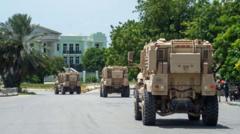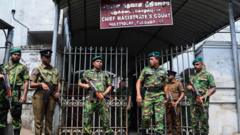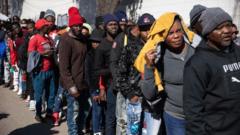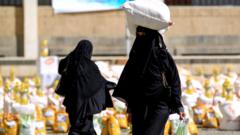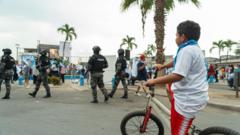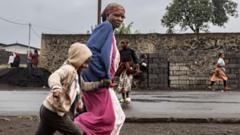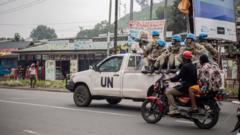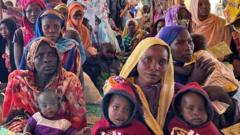In a country on the brink of collapse due to overwhelming gang control, families and officials grapple with the aftermath of violence and the hope for a peaceful future.
**Haiti's Turmoil: Inside the Battle Against Gang Violence with Kenyan Forces**
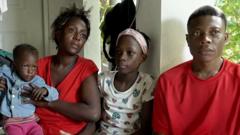
**Haiti's Turmoil: Inside the Battle Against Gang Violence with Kenyan Forces**
A glimpse into the escalating crisis in Haiti as foreign troops confront rampant gang violence.
In Port-au-Prince, the desperate conditions continue to worsen, exemplified by two-year-old Shaina, who is receiving treatment for acute malnutrition at one of the few operational hospitals. Her mother, Venda, fears for her daughter's life amid rampant gang violence that has gripped the capital. Shaina is one of over 760,000 children facing the threat of famine in Haiti, a crisis that escalated following the assassination of President Jovenel Moïse in 2021. With approximately 85% of the city under gang influence, many parents live in fear, making it dangerous to seek necessary medical care.
Venda describes the excruciating wait to reach the hospital where she hopes it is not too late. The UN reports that 5,000 lives have been lost this year due to the violence, which now permeates even the sanctuary of healthcare facilities. Hospitals are not safe, as exemplified by a recent clash between police and gang members that erupted in an emergency ward, terrifying patients.
One victim, Pierre, recalls being a bystander in a gang crossfire, emphasizing that improved government stability and youth programs could deter young men from joining gangs. The situation has prompted the UN Security Council to approve a Multinational Security Support Mission (MSS), led by Kenyan forces, to help restore law and order. Arriving in June, the Kenyan contingent has faced fierce resistance, with an official estimating around 12,000 armed gang members in Haiti.
During a patrol, Kenyan officers navigate the desolate streets of Port-au-Prince in armored personnel carriers, encountering violent confrontations with gangs. The police are outmatched and outnumbered, often enduring gunfire while trying to contain the chaos. Despite the dire circumstances, Commander Godfrey Otunge remains optimistic, stating that the local population supports the mission and seeks calm.
Gangs continue their reign of terror, with reports of coordinated attacks resulting in numerous civilian casualties. The overwhelming presence of gangs in areas like Wharf Jérémie highlights the severity of the crisis, as children as young as nine are being recruited. Ti Lapli, leader of the notorious Gran Ravine gang, argues that the chaos stems from a lack of jobs and government services, while ignoring the devastation his own gang has inflicted on the economy.
As civilians suffer, many, like Negociant, have been displaced from their homes due to the violence. Forced to live in makeshift camps, she expresses the heart-wrenching reality of seeking safety for her children amid the turmoil that has overwhelmed her life. The relentless cycle of violence and poverty raises pressing questions about the future for families in Haiti and the possibility of peace amidst such despair.
Venda describes the excruciating wait to reach the hospital where she hopes it is not too late. The UN reports that 5,000 lives have been lost this year due to the violence, which now permeates even the sanctuary of healthcare facilities. Hospitals are not safe, as exemplified by a recent clash between police and gang members that erupted in an emergency ward, terrifying patients.
One victim, Pierre, recalls being a bystander in a gang crossfire, emphasizing that improved government stability and youth programs could deter young men from joining gangs. The situation has prompted the UN Security Council to approve a Multinational Security Support Mission (MSS), led by Kenyan forces, to help restore law and order. Arriving in June, the Kenyan contingent has faced fierce resistance, with an official estimating around 12,000 armed gang members in Haiti.
During a patrol, Kenyan officers navigate the desolate streets of Port-au-Prince in armored personnel carriers, encountering violent confrontations with gangs. The police are outmatched and outnumbered, often enduring gunfire while trying to contain the chaos. Despite the dire circumstances, Commander Godfrey Otunge remains optimistic, stating that the local population supports the mission and seeks calm.
Gangs continue their reign of terror, with reports of coordinated attacks resulting in numerous civilian casualties. The overwhelming presence of gangs in areas like Wharf Jérémie highlights the severity of the crisis, as children as young as nine are being recruited. Ti Lapli, leader of the notorious Gran Ravine gang, argues that the chaos stems from a lack of jobs and government services, while ignoring the devastation his own gang has inflicted on the economy.
As civilians suffer, many, like Negociant, have been displaced from their homes due to the violence. Forced to live in makeshift camps, she expresses the heart-wrenching reality of seeking safety for her children amid the turmoil that has overwhelmed her life. The relentless cycle of violence and poverty raises pressing questions about the future for families in Haiti and the possibility of peace amidst such despair.



